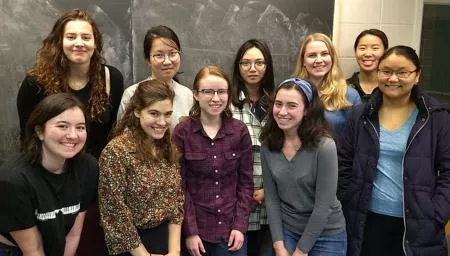This article appeared in the Fall 2017-Spring 2018 Bryn Mawr Math Alumnae Newsletter.
The Sound of Numbers is the most intriguing Bryn Mawr Emily Balch seminar to be introduced this year. Named for a notable Bryn Mawr alumna, the Emily Balch seminars are writing-intensive courses that are meant to serve as an introduction to work at the college level. Prof.s from different departments each choose the topic of the Emily Balch seminar they’d like to teach, and students select the section they’d like to enroll in. Amy Myers of the Bryn Mawr Math Department, inspired by the work of mathematician and musician Rachel Hall, chose to offer a course that explores the relationship between math and music. And I, driven by my love for both subjects and my interest in a seminar that seemed unlike any other, chose to enroll in The Sound of Numbers last fall.
Rachel Hall researches and teaches music and mathematics at St. Joseph's University in Philadelphia. She is a former member of the musical ensembles Broadside Electric and Simple Gifts, and an author of the shape-note songbook The Shenandoah Harmony.
A twist on the typical writing workshop, The Sound of Numbers presents basic math concepts and applies them to music and poetry. With the help of Hall’s materials and Myers’ instruction, students analyze sine functions and the waveforms of sound, use patterns from Pascal’s triangle to list possible poetic meters, employ modular arithmetic to describe rhythm, and much more. All the while, students write essays about the definitions and relationships they encounter and present their own arguments about the relationship between math and music while analyzing and defining the arguments of others.
The uniqueness of the class is amplified, too, by the diversity of students that enroll in it. Every Tuesday and Thursday of the fall semester, Park 336 was home to math-lovers and math-haters, musicians and music-listeners, and everyone in between. It might be startling at first, but “The Sound of Numbers” is interdisciplinary in a way that is surprisingly natural. “Humanities people” and “STEM people” relate to and help one another through peer-editing, brain-storming, and group discussion—bridging the divide. The focus is not on intensive reading or developing a uniform perspective on the material, but rather on making connections in reading and improving technique in writing. Within that model, there is plenty of room for diversity. And finally, in conferences with the professor, students prepare themselves for office hours and adapt to a college environment in which students and faculty work together.
The Sound of Numbers is the quintessential Emily Balch seminar: it builds comprehension in two beautiful subjects and does so for an unlikely community of people. In short, I’d say, it makes the transition from high school to college as eye-opening and satisfying as a good proof.
